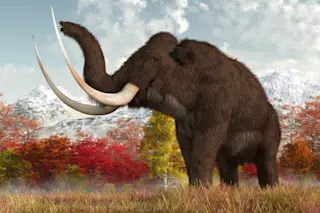One day, about 11,000 years ago, a lone bull mastodon plodded through the shallows of a lake in what today is Michigan. Some time later, three females and a gamboling calf passed the same way. Luckily for paleontologists, clay-rich mud filled the animals’ footprints, preserving the tracks and giving scientists insights into the mastodons’ social structure. The long-extinct creatures likely lived in matriarchal herds, while mature males roamed singly, much like their modern-day relatives: elephants.
Today, elephant numbers have dwindled, as has their range. They’re now considered vulnerable in Africa and endangered in Asia. But during the Pleistocene epoch, between 2.6 million and 11,700 years ago, elephants and their diverse relatives stomped across an impressive swath of the globe, from the Arctic to South America. Even back then, elephants were the most plentiful, diverse and widely distributed of this group, the Proboscidea. It also included mammoths, mastodons, and less well-known members such as stegodons and gomphotheres. Their trunks and tusks make them all recognizable cousins.
Thanks to fossils, preserved tracks, recent finds of proboscideans frozen in permafrost, and new technologies used to probe these ancient lineages, researchers are learning more about the lives and deaths of proboscideans, says Daniel Fisher, a paleontologist at the University of Michigan in Ann Arbor.
Dick Mol and colleagues’ find of the bones of the Yukagir Mammoth in Siberia inspired the creation of this replica of the extinct animal, tusks, hair and all. (Credit: Remie Bakker, Manimal Works, Rotterdam)
Fisher studies fossil tusks because they grew throughout the animal’s life, preserving a record of nutrient intake and habits. “They essentially carry diaries of their lives around with them,” says Fisher. His team finely analyzes the layers of dentin in fossilized tusks. These layers provide data on individual months, or even weeks or days, in a proboscidean’s lifetime.
Fisher expects his analyses will answer the ultimate question: What happened to these creatures? At the end of the Pleistocene, most proboscideans, along with many other large mammals, disappeared from the Earth. It wasn’t a sudden event, notes Dimila Mothé, a postdoctoral fellow in the mammalogy lab at the Federal University of the State of Rio de Janeiro; new fossil finds show that species in some parts of the world held on for several thousand years, or in some cases tens of thousands of years, longer. Still, by modern times, the once-diverse proboscideans — which numbered a dozen or so during the Pleistocene — had dwindled down to just two or three species, depending on how you count.
Two main explanations for the massive creatures’ departure have long been debated. One is that changes to the climate resulted in an environment — warmer, perhaps drier, or with more seasonal changes — that most proboscideans could not tolerate. The other is that humans hunted the animals to extinction.
It’s a question with resonance for the future as well as the past. The current decline in elephant numbers may not be a new extinction event, but simply the tail end of the ongoing extinction of all proboscideans, suggests Mothé. Understanding the plight of the Pleistocene proboscideans could help scientists predict or avert the fate of their modern descendants.
Here are some of the latest insights into daily lives and eventual disappearance of the prehistoric proboscidean:
1. Mammoth Diets Included Some, Well, Interesting Things
In 2007, reindeer herders in Siberia discovered the frozen carcass of a female mammoth calf. Named Lyuba, for the wife of the herder who reported the find, the calf had suffocated in a pool of mud about 40,000 years ago. The mud preserved not only her body, but the contents of her gut, too.
She had consumed milk, no surprise for a one-month-old calf (her age was apparent from the layers of dentin in her teeth.) Her stomach also contained chewed-up plant remains — yet she wasn’t mature enough to have done the chewing herself.
And there was something else in the intestine: fungi that typically grow in poop. For Fisher and the other paleontologists, the conclusion was clear: Lyuba had noshed on mammoth feces that included both fungi and undigested plant matter.

Discovered in 2007 in Russia’s Arctic Yamal Peninsula, Lyuba died roughly 40,000 years ago, only a month old. Her skin and organs were well preserved, and studies of the contents of her stomach and intestine have led to new understandings of mammoth diets. (Credit: Matt Howry/Wikimedia Commons)
Matt Howry/Wikimedia Commons
Discovered in 2007 in Russia’s Arctic Yamal Peninsula, Lyuba died roughly 40,000 years ago, only a month old. Her skin and organs were well preserved, and studies of the contents of her stomach and intestine have led to new understandings of mammoth diets. (Credit: Matt Howry/Wikimedia Commons)
Modern elephants do this too. Babies obtain the microbes they need for digestion from Mom’s waste. Adults also eat feces, a practice scientists call coprophagy. Because of the way their digestive systems are set up, coprophagy helps the animals extract additional nutrients from their food.
The scientists found other oddities in Lyuba’s digestive tract: mammal hair and a vole bone. What were those items doing in the gut of an herbivore? Perhaps, as the springtime weather melted snow and revealed the vole’s stored hay, the hungry mammoth mother gobbled up the animal along with the hay by accident, Fisher speculates. But eating rodents could also have been a way for mammoths to gain extra nutrients at the end of the winter.
2. Woolly Mammoths Roamed a Land That Was Cold but Not So Snowy.
Of course, the main dish for a proboscidean was vegetables, and the kinds of plants they ate can tell scientists something about where the animals lived. Clues can be found in the carbon in the animals’ fossilized tusks and teeth. Different kinds of plants contain different ratios of carbon isotopes, which are reflected in tooth fossils and allow scientists like Fisher to glean information on diets. From those same ratios, he can even infer when the animals were living off their own fat stores during wintertime.
Another piece of evidence comes from tooth wear. Grasses contain mineral particles called phytoliths, which leave scratches on the teeth. Bushes and trees, containing fewer phytoliths, create a different pattern. The scratches in fossilized teeth reflect the diet of a creature in its final weeks or days.
“We call it the ‘last supper’ effect,” says Gina Semprebon, a paleoecologist at Bay Path University in Longmeadow, Massachusetts.
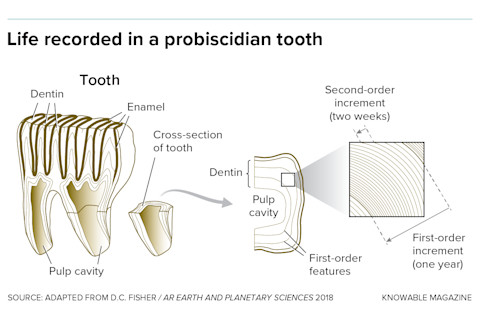
Ancient mammoths and mastodons incorporated records of their entire lives in their teeth and tusks. In a tooth, layers of dentin are laid down over the animal’s lifetime. Carbon isotope ratios in the dentin layers can tell researchers about the kinds of plants and amounts eaten. Scratch patterns on the enamel also yield information about what the animals ate.
Ancient mammoths and mastodons incorporated records of their entire lives in their teeth and tusks. In a tooth, layers of dentin are laid down over the animal’s lifetime. Carbon isotope ratios in the dentin layers can tell researchers about the kinds of plants and amounts eaten. Scratch patterns on the enamel also yield information about what the animals ate.
“What really impresses me about the proboscideans is the flexibility in their diet,” she adds. They could eat grasses or shrubs at different locales and times in their lives; at least one lineage switched its preference as it evolved. Or two species in the same area could split the options, with one focusing on bushes and one on grasslands. “That’s how you survive, long-term, in evolution,” says Semprebon.
The findings can get more specific than just grasses versus shrubs, though. Dick Mol, a mammoth researcher at the Rotterdam Museum of Natural History in the Netherlands, once obtained the frozen intestine of what is called the Yukagir mammoth, discovered in Siberia’s Yakutia region in 2002. He took it back to the Netherlands, thawed it, and to his surprise, found it was full of undigested food and dung.
Mol immediately phoned Bas van Geel, a paleoecologist at the University of Amsterdam. Van Geel arrived at Mol’s home half an hour later; subsequently, he analyzed the gut contents by microscopy, chemistry and DNA sequencing.
The researchers found dung-inhabiting fungi, supporting the coprophagy theory. They also found plant remains and pollen from grasses and sedges, as well as herbs, mosses and dwarf willow twigs. The plants were of types adapted to frigid, dry conditions and open spaces — an environment that researchers envision as the “mammoth steppe.”
“The woolly mammoth was living on a cold and dry, almost treeless, mammoth steppe environment,” says Mol. With little snow, the mammoths would have been able to dine on freeze-dried plants throughout the winter, suggests van Geel.
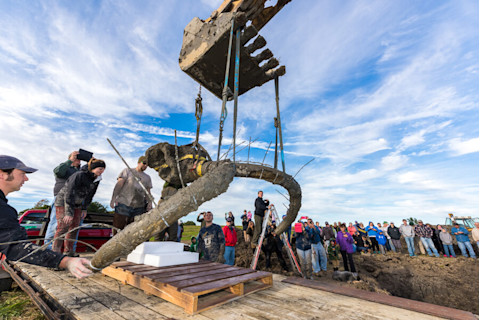
University of Michigan’s Dan Fisher and his team oversaw the excavation of a mammoth skull and tusks found on a soybean farm near Chelsea, Michigan in 2015. Nicknamed the Bristle mammoth, after farmer James Bristle, the fossils were from an adult male that died more than 10,000 years ago. (Credit: Daryl Marshke/Univ. of Michigan Photography)
Daryl Marshke/Univ. of Michigan Photography
University of Michigan’s Dan Fisher and his team oversaw the excavation of a mammoth skull and tusks found on a soybean farm near Chelsea, Michigan in 2015. Nicknamed the Bristle mammoth, after farmer James Bristle, the fossils were from an adult male that died more than 10,000 years ago. (Credit: Daryl Marshke/Univ. of Michigan Photography)
3. Woolly Mammoths had Cold in Their DNA.
Elephants live in warm climes such as desert or savannah. How did their ancient relatives, the woolly mammoths, survive that chilly steppe? In 2015, scientists reported the genome sequences of three Asian elephants and two woolly mammoths. Comparing the DNA of the ancient and modern creatures, a team led by Stephan Schuster, a genomicist at Nanyang Technological University in Singapore, identified differences in hundreds of genes.
These genetic differences, Schuster and his colleagues reason, gave mammoths adaptations like thick fur and smaller ears, the better to conserve body warmth. Other distinctive mammoth genes likely played a role in the animals’ fat storage, temperature sensitivity, blood sugar regulation and weight. The scientists think that these adaptations would also have helped the animals thrive in cold. Even genes associated with circadian rhythms differed, which might reflect an adaptation to cope with the midnight sun of arctic summers and the dark days of northern winters.
A woolly mammoth trunk found in Siberia in 2010 also suggests adaptation to the cold. The trunk skin contains a hoodlike expansion, which might have served as a sort of “fur mitten” that the mammoth could tuck its frost-nipped trunk tip into.
4. You Do Not Want to Mess With the Musth
Modern-day male elephants, about once a year, enter a phase called “musth” when their thoughts turn to mating and their testosterone levels skyrocket to as much as 60 times normal. For weeks or even months, they become aggressive, and testosterone-rich liquid dribbles from glands next to their eyes.
Did Pleistocene proboscideans do the same? While paleontologists can’t be sure, the evidence indicates that they did. Using CT scans and other techniques to examine the dentin layers from tusks, Fisher has shown that mature male proboscideans regularly fasted, as modern elephants do during musth.
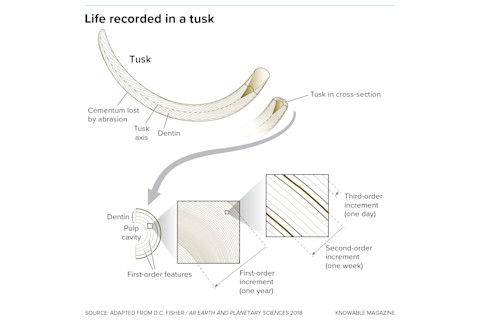
By slicing and finely analyzing fossil tusks, researchers can learn what ancient mammoths, mastodons and other proboscideans ate or where they lived during each year of their lives. Finer layers can allow scientists to parse weeks or even days at a time.
By slicing and finely analyzing fossil tusks, researchers can learn what ancient mammoths, mastodons and other proboscideans ate or where they lived during each year of their lives. Finer layers can allow scientists to parse weeks or even days at a time.
Researchers have also observed evidence of a gland like the one in modern elephants in several frozen specimens from Siberia. And some fossils have preserved evidence of the male-on-male violence that typically happens during musth. For example, the Crawford mammoths found in Nebraska are two adult males who locked their tusks around each other’s heads and died, likely of dehydration and starvation, while still hooked together.
The likelihood of musth is another piece of evidence, along with the Michigan footprints, suggesting that early proboscideans maintained a social structure similar to elephants today, with matriarchal herds and solitary adult males.
Fisher sees records of female reproductive status in tusks, too. This, presumably, reflects the slower or faster growth rate of the tusk in times of poor or rich food supply. But in adult females, Fisher sees a regular, multiyear pattern. The thickness of annual layers drops for about 2.5 years, then rises for 1.5, making a four-year cycle. He thinks this reflects a nearly two-year pregnancy, similar to the gestation period of modern elephants, when calcium and phosphorus are diverted from teeth and tusks to the growing fetus. That, he suspects, would be followed by the time the mother spent nursing her calf, which could also divert minerals from teeth and tusks.
5. New Evidence From Mammoth and Mastodon Fossils Hints at Humans as Prime Suspects in the Animals’ Disappearance. But the Jury is Still Out
In those calving cycles and other tusk patterns, Fisher seeks the explanation for the extinction of most mastodons, mammoths and their relatives. Based on his new analyses of dentin layers and radioactive isotopes in tusks, never done before at so fine a resolution, he’s concluded that human hunters are to blame. Here’s his reasoning, with respect to calving rates:
If climate change made it hard for mammoths to find food and survive, then they would have had fewer calves, with longer intervals between births. Studies of their tusks should reflect nutritional deficiencies.
But what Fisher sees in the tusks is mammoths enjoying solid nutrition, fast growth and regular, frequent reproduction, particularly as the Pleistocene drew to a close. That’s the pattern he’d predict if hunters were picking off herd members, because there would have been more food around for those still living.
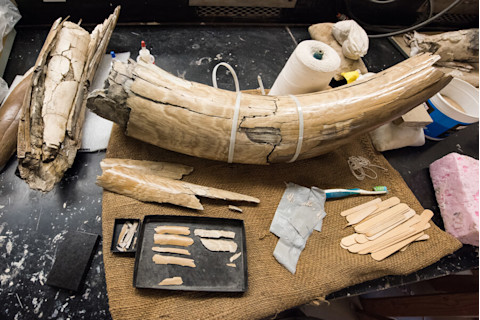
In Dan Fisher’s lab, a fossilized tusk is painstakingly put together from hundreds of fragments. (Credit: Daryl Marshke/Univ. of Michigan Photography)
Daryl Marshke/Univ. of Michigan Photography
In Dan Fisher’s lab, a fossilized tusk is painstakingly put together from hundreds of fragments. (Credit: Daryl Marshke/Univ. of Michigan Photography)
“It doesn’t matter whether you look at growth rates, you look at age of maturation, first calving or calving intervals, they all change in the direction predicted by the hunting hypothesis,” says Fisher. However, he cautions that he’s looked at only several dozen tusks so far, and he would like to have ten times as many data points to build his case.
Most other scientists think climate change played a more important role. “The demise of the mammoth steppe was dramatic,” says Mol. Analysis of pollen in lake sediments reflects a major climate change about 13,000 years ago, with the dry steppe and grasslands turning to wet tundra and forests, says van Geel. Plus, he adds, the wet winters would have meant more snow, and the animals might have struggled to find food under accumulated drifts.
Schuster also supports the idea that climate was the major factor. It would have been hard for large proboscideans to move on the soggy ground, he says. Plus, his DNA analyses indicate that one group of mammoths died out before people ever entered its range. “We are totally off the hook for that extinction,” he says.
Schuster also thinks that going after an animal as large as a mammoth would be a risky proposition for a band of early humans. Mol, too, doesn’t dispute that people may have killed mammoths, but doubts we killed them all.
Of course, the answer needn’t be black or white. Both Mol and Van Geel suspect that multiple factors were at play, including not only climate and hunting, but also illness, inbreeding and isolation as populations dwindled.
Certainly, it’s likely that more than one factor doomed the Pleistocene proboscideans, agrees Fisher, but he still argues that the hunting was a stronger factor than climate change.
What does that mean for the elephants — the only remaining proboscideans?
Poaching and Habitat Loss: Clear Threats to Elephants
According to the organizers of World Elephant Day, elephant populations have dropped by 62 percent in the last ten years. There are about 400,000 African elephants left, and fewer than 40,000 Asian elephants. In this case, it’s clear what is killing the elephants: poaching driven by humankind’s desire for ivory. Habitat loss due to human activity is also a factor.
But this time, humans are paying attention. Thanks to the Convention on International Trade in Endangered Species of Wild Fauna and Flora, ivory trade has been banned officially since 1990. Elephant lovers are using trackers and other technology to find elephants and protect them from poachers. Bay Path’s Semprebon, for one, hopes that as people become aware of the remarkable history of proboscideans, they’ll be more eager to save the last ones.
10.1146/knowable-111718-2
Amber Dance is a freelance science writer in Los Angeles. Her favorite place in the world is an elephant rescue preserve in Thailand.
This article originally appeared in Knowable Magazine, an independent journalistic endeavor from Annual Reviews. Sign up for the newsletter.


